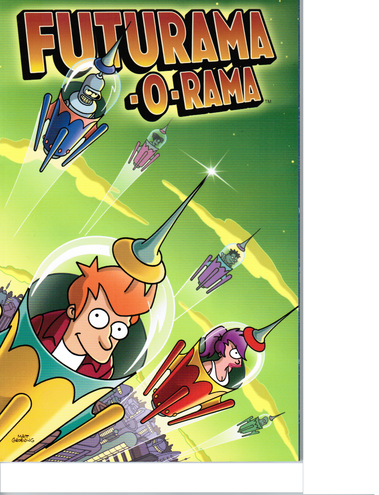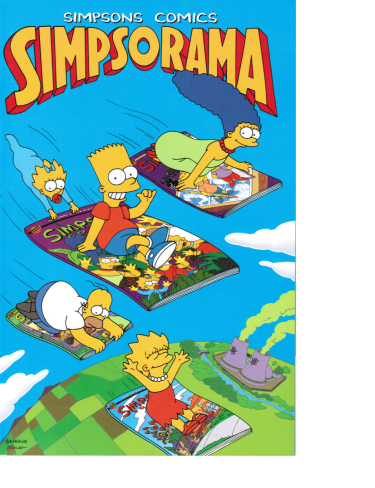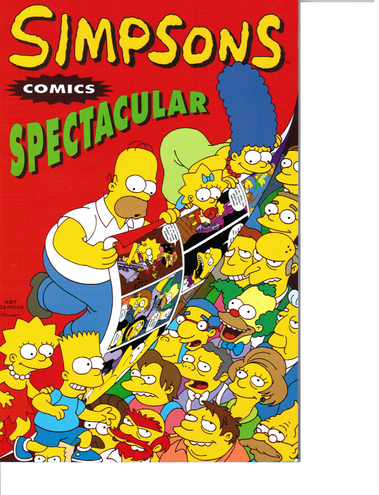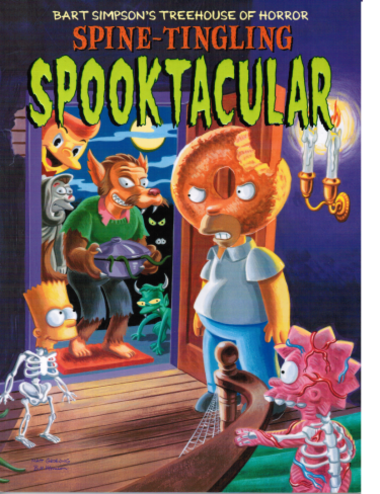
Almost from its start nearly twenty years ago, Bill Morrison has headed up Bongo Comics imprint, publishing a small line of exceeding fine and funny comic book series, collections, and mini-series based on Matt Groening’s signature creations, The Simpsons and Futurama.
It’s a demanding job, true, one which rarely garners much real notice outside of that of fellow professionals and an ever-growing sea of fans. But it is also a job that offers rich and varied rewards, as this and the next installment of TMR’s exclusive extended interview with the man ultimately responsible for some of the most popular all ages comics being published today.
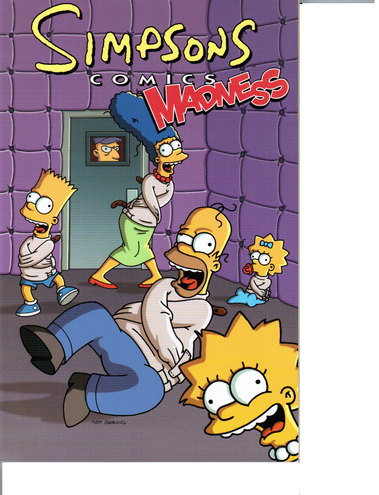 How do you describe what you do when asked about it?
How do you describe what you do when asked about it?
Well, I helped Matt Groening start the company way back in 1993. Originally I was the art director. And then, after the first year, Steve and Cindy Vance, who were the editors, left the company and I became the editor/art director. I basically had two jobs.
Over time the company’s grown, and we now actually have an art director—Nathan Kane—who I work very closely with making sure the look of the comics is what we’re after. But I didn’t want to still be editor/art director, because that sort of steps on what Nathan does, and I didn’t want to be just editor, because it didn’t accurately describe everything I do, because I’m very much involved in the art work as well.
I’ve worked in other industries where the term creative director is a common one. I’ve worked in advertising, and a lot of ad agencies have creative directors, and so I thought, “Well, that’s a pretty accurate descriptive term for what I do.”
 So I just sort of declared myself the creative director and nobody objected, so that’s what it says on my business card. (Laughs)
So I just sort of declared myself the creative director and nobody objected, so that’s what it says on my business card. (Laughs)
Did it come with a raise?
No. (More laughter)
Basically what I do is I oversee all the creative aspects of Bongo. So anything that has to do with writing or art, ultimately I’m in charge of that, I’m responsible for that. I try to let the business decisions fall to other people in the organization, although sometimes I do have a say and a voice in that.
But the thing that I really like to focus on is just how our books look and how they read.
What was your original edict from Matt? What was your mission statement then, at the start, and how might it have changed over the years?
That’s a good question. We don’t have a formal mission statement, but it’s really always been, for me, personally—and although Matt’s never given me marching orders in this direction, I know that he agrees—that our purpose in doing these comics is to provide Simpsons and Futurama fans with something that is completely compatible with the TV shows that they love.
I guess the best way to explain it is that, when I was a kid, it really used to bother me when I used to read a comic book that was based on an animated cartoon, or an animated show, or an animated movie that seemed really different from the original source material.
For example, I remember reading the Roadrunner and Coyote comic books, and the Roadrunner talked in those comic books, and it would drive me nuts. I was like, “The Roadrunner doesn’t talk!” And I understand now, as a comic book creator, I understand that it would have been really difficult for them to do a regular comic book with the Roadrunner and the Coyote without the characters talking. You know, to do them without voice like the original cartoons were done.
So I get that, but at the same time it just seems inauthentic, you know?
Yeah.
It bothered me that the Bugs Bunny comic books, they created this cast of nephews, like the (Carl) Barks version of Disney’s ducks. And they gave Bugs Bunny, girlfriend, or a wife. I don’t know what she was. But they just seemed different. They seemed like they were in a different universe. And it’s always been my goal…
One of the best things I can hear from a fan, and I hear this pretty often, is that fans will come up and say, “I read such and such issue of Simpsons Comics or Futurama Comics, and I thought, ‘That could be an episode of the show,’” or “It was so good, it was like watching an episode of the show.” And that’s really what I’m going for. That’s what everyone at Bongo is shooting for when we make these comic books.
If people can read our comic books and actually get so wrapped up in the experience that, a month later, they can’t remember whether this was an episode of the show they watched or if it was a comic book they read, then we’ve done our job.
I’ve actually heard people talking about that at shows. And, as a matter of fact, I’ve also overheard arguments about that, whether a certain story was in reality an episode or one of the comics.
Really?
Yeah, I have, really. (Laughs)
Cool. (Laughs)
It really was, now that you mention it. Still makes me laugh when I think about it.
That’s great.
And the other aspect of that is continuity, you know? We’re fans of both shows. We watch them religiously, and if there are changes made in the TV shows, then those changes get reflected in the comic books, as well. I like to keep a real seamless transition between the two mediums.
So if Bleeding Gums Murphy shows up in one of the comics, it’s either gotta be a flashback or he’s a ghost.
Right, just as Maud (Flanders) is no longer living in the comic books. She kind of was for a while after she died on the TV show, just because we had stories already in the works that featured here. But once we worked through those stories, then we just eliminated her as a character. Unless she comes back as a ghost, which even in the TV show, she has.
Yeah, if nothing else as a figment of Neddy’s troubled conscience.
Yeah.
What are some of the unique challenges you face in your job, and given the current economic climate, what are some of the unique challenges that the entire line is facing?
Well, the biggest challenge is just the expense of comics. They’re not a dime or 12 cents anymore, obviously. And it’s really difficult to—especially for kids, who are a big part of our audience—it’s difficult to get them to shell out three bucks for a comic book when they can get a video game and play it forever. I don’t know what the cost is these days…
Hell, you can probably rent games for three bucks or even less these days.
Yeah, you could rent one and then just play it over and over and over again, and you get hours of enjoyment. Whereas a comic book, once you’ve read it, unless you’re an avid collector and like to put them in plastic bags and keep them and get them out and look at them every once in a while, it’s kind of a lot of money to spend for something that you might not enjoy for more than a half hour.
And that’s one of the reasons why we really try to give readers a lot for their money. We try to add more pages of actual content in our books than other comic book companies have, and we just try to make it a more substantial read. There aren’t a lot of long, silent fight scenes in our comics—which, if you’re a superhero comic book fan, you know those can go by pretty fast. Hey, I’ve read some comics in just a couple of minutes, and you get to the end and you just go, “Wow. I can’t believe I spent three bucks on that.”
Or four, as the case may be.
Yeah.
Another thing; how long are your typical story arcs again? I mean, don’t you have to collect at least six issues to get a complete story, right?
No, ours are done in one issue. (Laughs)
Remind me, do you do multiple stories in a single issue these days or not?
Well, we’ve done that on occasion. It’s really not the norm for us. And we’ve also done a mini-series recently featuring Comic Book Guy. It was a five issue series.
But that’s a rarity, too, if memory serves.
Yeah, those are the rarities. Normally, you can just pick up whatever issue of any of our comics and enjoy it. It’s a complete read. You don’t have to worry you missed the issue before, or that you might not be able to find the issue that comes after.
And retailers love that, too, because they can keep the comic books on the racks longer. I’ve gone into comic shops where you see Simpsons Comics issues from 10 years ago—not that they’ve been sitting there that long, but we have a lot of inventory that retailers can order from.
Right, because once a retailer realizes that you make your money on repeated sell through of stock, they’ll immediately reorder and then sell those issues again.
I’ve got to ask, do you think that the single issue is doomed? And what do you see replacing it as the basic unit for publishers and, more importantly, readers?
Yeah, it’s definitely winding down. The 32 page pamphlet, as I like to call it, is…
I mean, I love them. I’m such a comic book lover that it really kills me to say this, because there’s just something cool about a comic book that is different from a trade collection. It’s very different from getting a comic book that read on your iPad.
But I know that’s the way that young people, who weren’t raised reading comic books, that’s going to be their medium of choice. It already is for a lot of comic book readers. And DC Comics just made this bold move (to what is known as day-and-date release,) where all of their books will come out digitally the same day that they come out in print. So it gives people an instant option. They don’t have to wait for the digital version anymore—myself included.
I have an iPad, and there are some comics that I want to read that I don’t necessarily want to collect. And those are the comics that I’m probably going to order and read on my iPad. There are still going to be comics that I want to keep, and just refer back to, and have a physical version of them. But it’s not going to be everything like it has been.
And you might just end up with a beloved graphic novel or two on there, as well.
Yeah.
Well, your answer kind of highlights what seems to be the current state of affairs, which is that it’s a multi-platform or -format world we’re living in, and that’s not such a bad thing.
So, how dire do you think the situation is at present for publishers of single issue comics, given the current state of the economy and marketplace?
I don’t think it’s dire at all. I think that there’s still a lot of money to be made for companies who produce books in both formats—both digital and printed. It’s just a matter a matter of the company being willing to switch to newer mediums. The ones that don’t are going to fall by the wayside, but the ones that do switch, I think…
People just love to read comics. I don’t think that’s going to go away. And who knows? Maybe the digital version might spark a renaissance. Whereas people were a little bit ashamed to read comic books in public, or to let their friends see them reading one of these 32 page pamphlets that viewed as a kiddy book, maybe that stigma isn’t attached to your computer or your iPad. And that might just spark a huge resurgence. Who knows?

